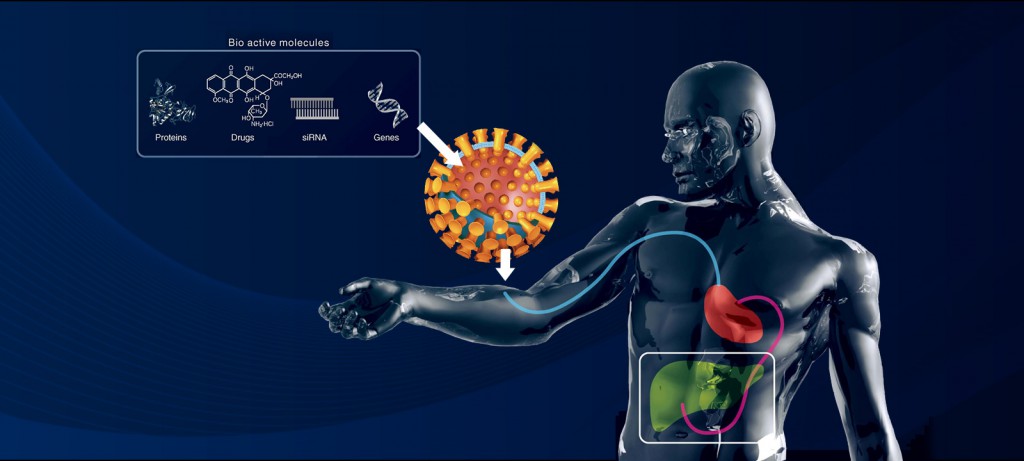DEVELOPMENT
Bionanocapsule technology
1. Structure of Bionanocapsule
Bionanocapsule (BNC) is a nano-size capsule produced by biotechnology. BNC is a hollow nano-particle expressing L-type surface protein of hepatitis B virus (HBV). BNC is produced by yeast whose gene was introduced by HBV’s L-protein gene. The surface protein, named L-protein, which resides in lipid membrane, has ability to specifically recognize human hepatic cells and to introduce the content of BNC into the cytoplasm. The L-protein is consisted of S region(having membrane-penetration motif), pre-S2 region and pre-S1 region(having human hepatic cell recognition site).

2. Types of Bio-nanopcapsule
The original BNC specifically recognizes human hepatic cells, but we have developed other types of BNC that recognize other cell types. Currently following types are available.
BNC-L
The original BNC which expresses L-protein whose amino acid sequence is identical with that expressed in natural HBV surface. BNC-L specifically recognizes human hepatic cells.
BNC-ST
BNC whose S region is modified so that it can escape from antibody raised against S-protein. This modification also contributes to reduce antigenicity. BNC-ST, like BNC-L, binds human hepatic cells.
BNC-ZZ
BNC that is inserted antibody-binding domains of Protein A into Pre-S region of L-protein. The BNC easily bind to antibodies and good for DDS targeting to non-hepatic cell and for antibody sensor.
BNC-ZB
BNC that is inserted antibody-binding domains of Protein A and Protein G into Pre-S region of L-protein. The BNC easily bind to antibodies and good for the use of antibody sensor. Several types exist depending on the number of inserted domains.
BNC-Bio
Biotinylated BNC. Through Biotin-avidin reaction, many targeting molecules, such as peptides, sugar chains, and lectins, can be attached to BNC.
BNC for HBsAg purpose
BNC is identical with recombinant HBsAg (HBV surface antigen). We make various type of HBsAg such as BNC-XT (high S-antigenic activity type)and M, or S typeHBsAg.
Pipeline
1. Active targeting DDS technology
BNC has abilities to recognize human hepatic cells and to introduce its content into cells. We have developed an active DDS technology which is composed of drug-encapsulated liposome-BNC. The active targeting DDS is applied for BCL-101 (Doxorubicin encapsulated BNC-Liposome, BNC-D) and in vivo siRNA delivery system. These technologies are under non-clinical developmental stage.

2. Protein-incorporated BNC technology
We developed a technology that can incorporate any protein into BNC. The incorporate protein can be introduced into cells by using BNC’s virus ability under non-invasive manner. The technology is good for investigate intracellular protein function, or in vivo delivery of active proteins for the development of new medical purpose.
3. Highly sensitive antibody sensor
Each antibody-binding BNC particle is consisted of about 100 protein molecules. Each protein has at least two antibody-binding domains and can be labeled one HRP molecule. Because each particle behaves as one sensor element, each element has at least 200 antibody biding site and 100 signal generating component which are about 100 times more than usual antibody, resulting in extremely higher sensitivity in immunoassays. We developed two products based on the MAD technology; highly sensitive- or rapid-detecting western blot kit(Easy-WESTERN) and ELISA construction kit (Easy ELISA Constructor). The technology can be used for immune-staining and other immunoassays.
4. Vaccines
BNC shows a particle structue consisting of about 100 proteins. Each protein has a membrane-penetrating domain and shows same conformation in the particle. It is generally recognized that particle structure showing antigen on the particle surface is highly antigenic and ideal for vaccine, as is BNC. We develops vaccines such as HBV vaccine, by using the property that BNC can display various proteins on the particle suraface.
5. Others
We also develop immunoassay-related products, and HBV-related research reagents.